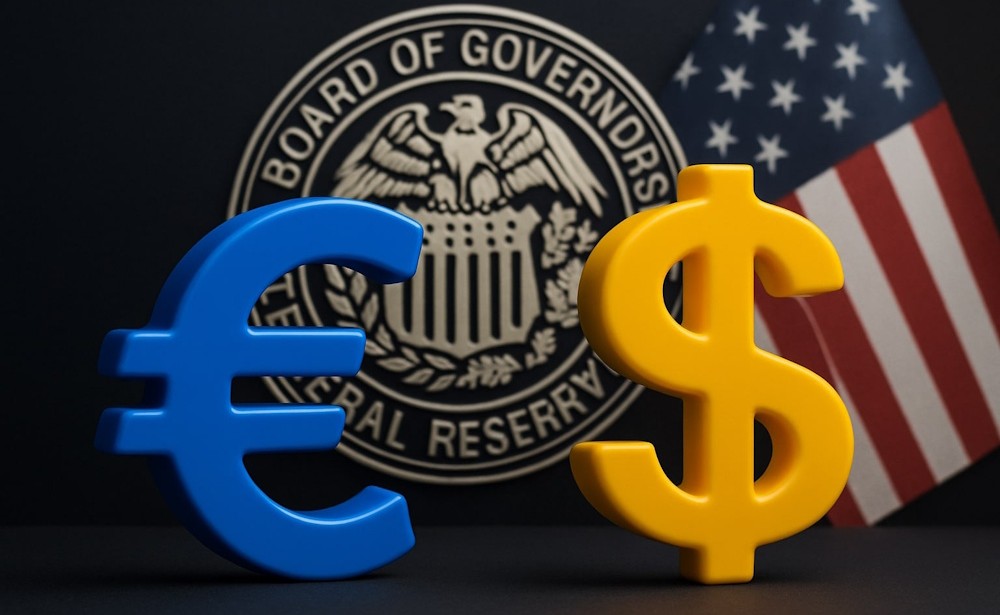The EUR/USD pair concluded the week at 1.1628, reflecting a decline of 0.20%. However, the significant developments are anticipated this Monday as market participants prepare for a pivotal FOMC decision that has the potential to recalibrate global FX valuations. The currency pair fluctuated within the range of 1.1665 to 1.1577 over the past week, exhibiting significant intraday volatility linked to postponed U.S. CPI data, a tenuous recovery in the eurozone, and considerable uncertainty regarding U.S. fiscal activities. The Federal Reserve’s meeting on October 29 is almost universally anticipated, with a 98.3% probability of a 25-basis-point rate cut. However, Chair Jerome Powell’s communication regarding quantitative tightening will be crucial in determining the subsequent movement for EUR/USD. Following the postponed U.S. CPI release—+0.2% MoM, +3.0% YoY—the EUR/USD surged to 1.1650, but subsequently retraced as market participants reevaluated liquidity and interest rate forecasts. The recent action represents the third unsuccessful effort this month to maintain levels above 1.1655, indicating that sellers persist in protecting that range. In light of the recent U.S. inflation data showing weakness, the euro’s rally was ultimately fleeting, as market participants focused more on the implications of policy tone rather than the surrounding data fluctuations.
The ongoing U.S. government shutdown, which has now extended into its third week, has resulted in significant data blackouts affecting employment and spending metrics. This situation leaves the Federal Reserve to operate without essential inputs for its decision-making processes. The market’s unease regarding absent data has limited speculative long positions in EUR/USD, even in light of dovish macroeconomic conditions. The markets are anticipating a 25 basis point cut from the Fed, which would adjust the federal funds rate to a range of 3.75%–4.00%. However, Powell’s insights regarding quantitative tightening may prove to be the more critical indicator. The Fed’s balance sheet runoff has resulted in bank reserves being approximately 10% of GDP, nearing the lower threshold of acceptable levels. Economists indicate that the Fed might completely stop Treasury runoffs to avert liquidity stress, thereby effectively injecting new reserves into the banking system. This action would structurally undermine the dollar. If confirmed, EUR/USD may surpass resistance around 1.1700, potentially targeting 1.1750–1.1800 in early November. The European Central Bank has maintained a neutral stance in the context of decreasing inflation and slow GDP growth. Headline eurozone inflation has decreased to 2.7% year-over-year, while core CPI has fallen to 2.8%, indicating the slowest rate of growth since 2022.
While the ECB indicated that rates have probably reached their maximum at 4.00%, officials continue to exercise caution regarding any premature reductions. The relative stability observed stands in stark contrast to the Fed’s aggressive pivot, suggesting that the euro may possess a latent yield advantage in the upcoming quarters. Market pricing for 2026 currently suggests that the ECB will implement cuts later than the Fed, a trend that has historically bolstered EUR/USD strength during mid-cycle transitions. EUR/USD is currently confined within a narrow consolidation range of 1.1570 to 1.1665, with momentum oscillators recalibrating following the decline observed in September. The RSI is currently at 49.5, indicating a neutral stance but showing signs of upward movement, while the MACD has shifted to a positive territory for the first time since early October. The behavior of prices around the 100-day moving average (1.1605) will dictate the short-term trajectory. A daily close above 1.1655 indicates a short-term breakout, setting 1.1720 as the next target; a failure to maintain 1.1590 could lead to a drop to 1.1550, the month’s low. Option flow data reveal significant strike activity near 1.1650 and 1.1750, suggesting that markets are positioning themselves for a potential upside resolution following the FOMC meeting. The U.S.–Eurozone two-year yield spread stands at +122 bps, favoring the dollar, having contracted by almost 30 bps since early September. Historically, a 25 basis points narrowing tends to correlate with an approximate 1.5–2% increase in EUR/USD over the subsequent quarter.
Projections are concentrated in the range of 1.20–1.24 through 2026, contingent on a relaxation of global financial conditions and a decline in U.S. real yields below 1.5%. The forward rate path suggests a steady structural recovery instead of a speculative spike. The long-term fair value models for EUR/USD, which are grounded in real yield parity and trade-weighted flows, currently indicate a center around 1.18. This suggests potential for gradual appreciation, contingent upon the Fed confirming a dovish cycle. Market participants characterize the prevailing foreign exchange landscape as “frozen liquidity.” The inconsistency in U.S. data releases, especially regarding payrolls and PCE, has diminished confidence in directional bets. Interbank liquidity in EUR/USD decreased by 14% month-on-month, as indicated by EBS market depth data, resulting in even small orders causing significant price movements. This clarifies the fluctuations surrounding CPI and FOMC expectations. The euro’s inability to maintain levels above 1.1650, in light of supportive fundamentals, highlights that market positioning continues to be cautious until Powell’s press conference offers further insight.

